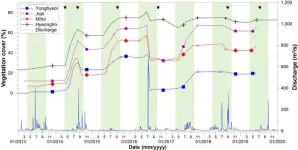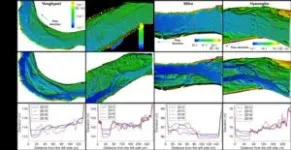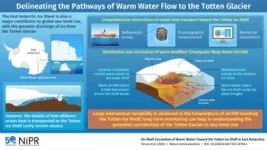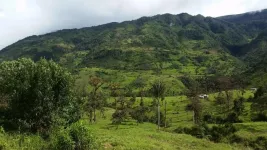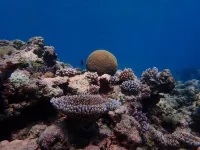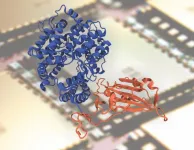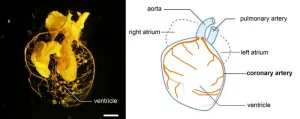Understanding river alteration via shifting flow regime
Long-term investigation shows bio-geomorphic alteration through shifting flow regime in a modified monsoonal river
2023-08-22
(Press-News.org) Researchers at the Korea Institute of Civil Engineering and Building Technology (KICT, President Kim Byung-suk) published their findings on the drastic short-term alterations in rivers accompanied by shifts in vegetation and geomorphology drawn from actual on-site investigation and analyses and not from model simulations.
The alteration processes from a 'white river,' characterized by riverbeds with no vegetation including bare sandbars, to a densely vegetated 'green river' with grass and trees, have been observed in various rivers. Rivers are where continuous interactions between flowing water, vegetation, and morphology occur. The alteration arises from a combination of both natural and human factors, such as climate change and environmental change in the watershed.
The alteration can also be triggered by short-term hydrological shifts like droughts, particularly in rivers affected by the monsoon climate, characterized by abundant precipitation in summer and prevailing dry conditions in winter. The research team led by Dr. Chanjoo Lee at KICT has conducted a research project in collaboration with the Dutch research institute Deltares to analyze the characteristics of short-term river alterations found in Naeseongcheon Stream, South Korea, and interpret their causes.
Naeseongcheon Stream, which flows through the inland areas of Gyeongsangbuk-do Province, is a dynamic sandy river with well-preserved natural features, vibrant vegetation dynamics, and active sediment transport due to hydrological fluctuations. KICT has been conducting long-term monitoring of the Naeseongcheon Stream since 2012 before significant vegetation encroachment started using light detection and ranging (or LiDAR) surveys, hydrological surveys, and vegetation mapping.
Dr. Chanjoo Lee’s research team used aerial photographs of the area from the 1990s to 2019, with LiDAR survey data gathered from 2013 for the project. The research findings revealed that Naeseongcheon Stream had experienced a gradual increase in vegetation encroachment on the riverbed since the 1990s, but the most significant surge occurred between 2014 and 2015. The sharp increase was attributed to a decrease in water flow and the absence of flooding due to a drought that affected the area during that period. As a result, the riverbed has undergone a rapid alteration from a typical white river to a heavily vegetated green river. From the geomorphological perspective, the sand river that once flowed wide and shallow became narrow and deep, allowing the surrounding areas once covered with water and sandbars to turn into lush floodplains overgrown with vegetation.
In the joint research, KICT and Deltares identified several underlying factors contributing to the changes in Naeseongcheon Stream, including artificial factors such as water quality issues (eutrophication) that many modern rivers face, rising spring temperatures that lead to early vegetation encroachment and growth, and climate change as an over-arching driver, which causes temperature rise and fluctuations in river flow.
Shorter white river phases formed by flooding and longer green river phases dominated by abundant vegetation can be observed as sand rivers in temperate climates like Naeseongcheon Stream gradually undergo sub-tropicalization caused by climate change. “Through this research, we gain insights into the interactions between hydrology, vegetation, and river morphology, which contribute to river alterations," said Dr. Chanjoo Lee at KICT, the lead researcher of the project. "We anticipate that the research findings can be utilized in formulating river management strategies, including flood control and vegetation management.”
###
The Korea Institute of Civil Engineering and Building Technology, a government-funded research institute with 40 years of extensive research experience, is at the forefront of solving national issues that are directly related to the quality of the people’s lives.
The research was conducted backed by the Ministry of Science and ICT. An article explaining the results of this research was published in the latest issue of River Research and Applications, a renowned international journal in the environmental sciences and water resources (IF:2.2).
END
ELSE PRESS RELEASES FROM THIS DATE:
2023-08-22
COLUMBUS, Ohio – Train elementary school students how to be creative and you can help increase their resilience in the face of real-life problems, new research suggests.
In a small study, researchers trained third, fourth and fifth graders to use literary techniques such as perspective shifting, counter-factual (what if) thinking and causal (why) thinking to improve creativity in dealing with difficulties.
The techniques helped kids come up with new, creative and practical ways to solve problems, said Angus Fletcher, lead author of the study and a professor of English at The Ohio State University and member of the university’s Project ...
2023-08-22
The first Americans over age 60 just started rolling up their sleeves to get vaccinated against respiratory syncytial virus, or RSV, now that brand-new vaccines have started to arrive at pharmacies and clinics.
Millions more older adults may do the same in coming weeks and months, a new University of Michigan poll suggests, as they seek protection against a virus that is especially good at infecting older lungs.
But nearly half of older adults do not know about the new RSV vaccines that received approval earlier this year, the poll finds. And some groups of older adults show much less interest in getting ...
2023-08-22
PULLMAN, Wash. — A shipping container that can test passive cooling systems could help researchers and builders find carbon-free ways to keep people cool in extreme temperatures.
Washington State University researchers created the 60 square-foot chamber to test passive systems that use wind towers along with water evaporation instead of electricity to cool spaces.
Finding cooling methods that don’t require putting more greenhouse gases into the air is crucial to helping a growing population adapt to climate change, said Omar Al-Hassawi lead author of the study in the journal, Energies.
“Cooling is ...
2023-08-22
One of the most feared effects of global warming is the rise in sea level caused by the melting of polar continental ice. In fact, polar researchers have been working towards raising the awareness of this impending threat. The scientific fraternity relies on sampling the remote regions of Artic and the Antarctic continental shelves to estimate these risks. They can then use these measurements to model and understand the processes that drive the melting of ice at these locations and determine the extent of meltwater that will eventually flow ...
2023-08-22
Birds native to the tropical Andes, many of which cannot be found anywhere else, are threatened by increasing agricultural development in the region. A new study details how the resulting habitat loss affects specific species and lays out possible ways to protect birds from human-driven disturbance.
The researchers combined a meta-analysis of papers on birds across the Andes with five years of fieldwork in Peru, revealing that open farmlands result in up to a 60% decline in the number of species in an area. Before this work, there was little data on which species were declining or by how much.
“The vast majority ...
2023-08-22
Coral reefs in one part of the Pacific Ocean have likely adjusted to higher ocean temperatures which could reduce future bleaching impacts of climate change, new research reveals.
A Newcastle University-led study focused on the Pacific Island nation of Palau and has shown that historic increases in the thermal tolerance of coral reefs are possible. The results demonstrate how this capacity could reduce future bleaching impacts if global carbon emissions are cut down.
Drawing on decades of field observations, the scientists modelled many possible future coral bleaching trajectories for Palauan reefs, ...
2023-08-22
For the first time, a group of researchers have successfully extracted ancient DNA from a 2,900-year-old clay brick.
The analysis provides a fascinating insight into the diversity of plant species cultivated at that time and place, and could open the way to similar studies on clay material from other sites and time periods.
The results are published today in Nature Scientific Reports.
Currently housed at the National Museum of Denmark, the clay brick originates from the palace of Neo-Assyrian king Ashurnasirpal II, in the ancient city of Kalhu. Known today as the North-West palace in Nimrud (modern-day northern Iraq), its construction began around 879 BCE. ...
2023-08-22
In a recently published article featured on the cover of the Biophysical Journal, Dr. Rafael Bernardi, assistant professor of biophysics at the Department of Physics at Auburn University, and Dr. Marcelo Melo, a postdoctoral researcher in Dr. Bernardi's group, shed light on the transformative capabilities of the next generation of supercomputers in reshaping the landscape of biophysics.
The researchers at Auburn delve into the harmonious fusion of computational modeling and experimental biophysics, providing a perspective for a future in which discoveries ...
2023-08-22
Coronary arteries are a vital part of the human heart, providing it with oxygen-rich blood so that it can work. By comparing the hearts of mammals, birds, reptiles, fish and frogs, a multi-institutional team of researchers appears to have found evidence that the structure of our hearts evolved in a stepwise process from fish, through amphibians to reptiles to mammals. When animals evolved from living in the water to living on land, a significant remodeling of the blood vessels to the heart occurred, enabling survival without gills. Understanding ...
2023-08-22
ROCKVILLE, Md.—For the first time, researchers have discovered that the ventral tegmental area (VTA) of the brain—a key structure involved in motivation and reward appreciation has altered connectivity patterns with specific brain regions in patients with obesity. Individuals with obesity have hyper-connectivity of the VTA with part of the ventral occipitotemporal cortex (visual processing for food images) and hypo-connectivity with the left inferior frontal gyrus (associated with cognitive control), according to a new study in Obesity, ...
LAST 30 PRESS RELEASES:
[Press-News.org] Understanding river alteration via shifting flow regime
Long-term investigation shows bio-geomorphic alteration through shifting flow regime in a modified monsoonal river
